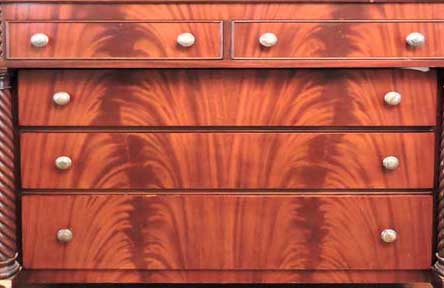Illustrated FURNITURE Glossary
Veneer

![]()
Illustrated FURNITURE Glossary
Veneer

Usually slices of wood between 1/16" and 1/32" in thickness sliced through the cross or vertical section of a flitch (any part of the log which is sliced into veneer). These thin, continuous slices are fairly identical as to grain and figure, and can matched in various ways to create interesting surface patterns.
Veneers are applied over a sturdy backing of a coarser, less decorative wood.
The effect of of veneered furniture or walls is that the area has been constructed completely of a finely grained or interestingly colored wood.
The technique of veneering, used before that of marquetry, consists of sticking sheets of precious woods onto the structure of a piece of furniture.
We can date the use of veneers back to ancient Egypt where they often used veneers of African ebony trees and glued them to boards of the less expensive cedar -- sometimes for a decorative pattern, sometimes to make the piece look like it was made wholly of ebony. The use of veneers has continued throughout our history.
Ebony was one of the first woods to be used in this way. In France, ebony, the only wood heavier than water gave its name to the craftsmen who used it - the "ébénistes" or cabinetmakers. Sawn by hand, the sheets of wood differed in thickness by more than one millimeter. Cut using a reciprocating power saw, their thickness varies by no more than 5 to 8 tenths of a millimeter and today by less than one tenth.
During the 16th century in Southern Europe, veneers were cut by hand to 1/10" in thickness.
In the reign of William and Mary, burr walnut veneers were applied over oak.
Chippendale, Sheraton, and Hepplewhite used mahogany and satinwoods as veneers, as well as in solid construction.
Burl veneer: Similar to a cancer, this unrestrained and multidirectional growth called burl by Americans (and burr by the British) displays a unique, marble-like pattern and is nearly always sliced into veneers.
Crotch (crotch veneer): This "flame" pattern of grain is revealed when a trunk or heavy branch with two forking branches is cut through its collective center. It is highly prized veneer cut from just below the fork of a tree. It always produces a highly figured V-grain of an extremely decorative character.
Flame veneer: See crotch above.
Swirl (swirl veneer): A wood grain effect which usually appears around knots or crotches. An irregular eddying grain. The effect is between plain grain and crotch grain.
Stringing / lining: A fine line of inlaid veneer
Banding: A narrow strip of veneer used as a border or edging on tabletops, drawer fronts, etc. Usually made of a contrasting inlay, it was popular in 18th-century furniture.
Book matching / two piece match: Two sheets in consecutive order as they were cut from the log are joined, appearing to be mirror images of each other. See Edge Jointing Veneer
Examples from Buffalo:
- Illustration above: 880 West Ferry St.
- Veneered top, skirt and pedestal, Empire pedestal center table, - Horace Reed House
- Crotch (flame) veneer on "Treaty Desk" - Kittinger Furniture Co.
- Crotch (flame) veneer on Hepplewhite sideboard - Kittinger Furniture Co.
- Crotch (flame) veneer on English Sheraton sideboard - Private collection, Orchard Park, NY
- Crotch mahogany - Drop leaf table - Lang Collection
- Bird's eye maple veneer on Sheraton drawer fronts - Dana Tillou Fine Arts
- Inventory: veneers / stringing / banding - Kittinger Furniture Co.
- Stringing on Eastlake chest of drawers - Hoover House, Amherst Museum
- Stringing and banding on Hepplewhite sideboard - Kittinger Furniture Co.
- Stringing and banding on Federal card table - Kittinger Furniture Co.
- Stringing and banding on Hepplewhite Washstand - Private collection, Buffalo, NY
- Contrasting colors - Old Editions Book Shop and Café
- Empire / Rococo Revival sofa - Boies-Lord House (Hamburg)
- Empire / Rococo Revival side chair - Boies-Lord House (Hamburg)
- Circa 1860 2-piece bookcase - Boies-Lord House (Hamburg)
- Maple veneer, circa 1860 sideboard - Boies-Lord House (Hamburg)
- Book matching veneers, Victorian davenport - Private collection, Orchard Park, NY
- Renaissance Revival style bed - McCann House
Other examples:
- Stringing on Federal sideboard - Fairmount Park Woodford House, Philadelphia, Pa.
- Stringing on Rococo desk - Hofmobiliendepot Imperial Furniture Collection, Vienna, Austria
- Burl veneer - Cane-seated side chair - Athenaeum, Philadelphia
- Walnut veneer, William and Mary highboy - Winterthur Museum
